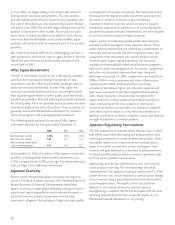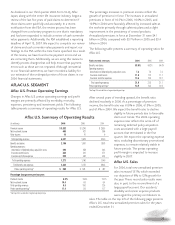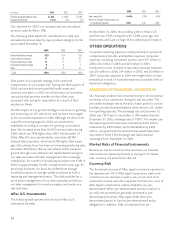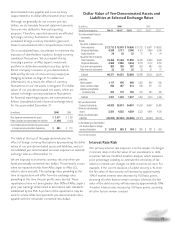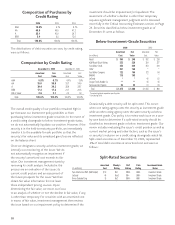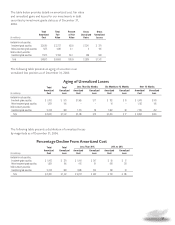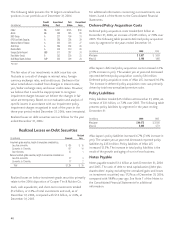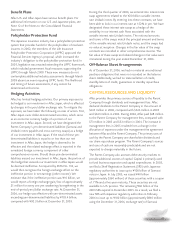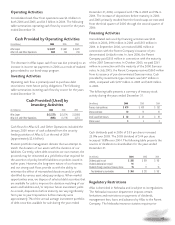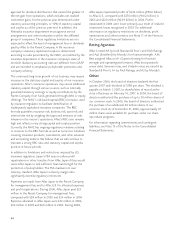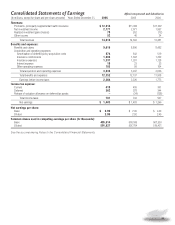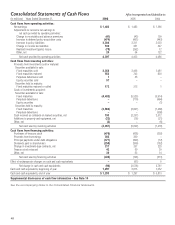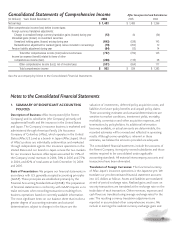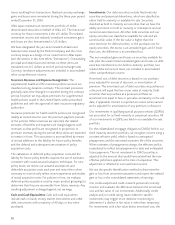Aflac 2006 Annual Report Download - page 45
Download and view the complete annual report
Please find page 45 of the 2006 Aflac annual report below. You can navigate through the pages in the report by either clicking on the pages listed below, or by using the keyword search tool below to find specific information within the annual report.
41
Benefit Plans
Aflac U.S. and Aflac Japan have various benefit plans. For
additional information on our U.S. and Japanese plans, see
Note 12 of the Notes to the Consolidated Financial
Statements.
Policyholder Protection Fund
The Japanese insurance industry has a policyholder protection
system that provides funds for the policyholders of insolvent
insurers. In 2002, the members of the Life Insurance
Policyholder Protection Corporation (LIPPC) approved the
Financial Services Agency’s proposal, which increased the
industry’s obligation to the policyholder protection fund. In
2005, legislation was enacted extending the LIPPC framework,
which included government fiscal measures supporting the
LIPPC through March 2009. These new measures do not
contemplate additional industry assessments through March
2009 absent an event requiring LIPPC funds. The likelihood
and timing of future assessments, if any, cannot be
determined at this time.
Hedging Activities
Aflac has limited hedging activities. Our primary exposure to
be hedged is our investment in Aflac Japan, which is affected
by changes in the yen/dollar exchange rate. To mitigate this
exposure, we have taken the following courses of action. First,
Aflac Japan owns dollar-denominated securities, which serve
as an economic currency hedge of a portion of our
investment in Aflac Japan. Second, we have designated the
Parent Company’s yen-denominated liabilities (Samurai and
Uridashi notes payable and cross-currency swaps) as a hedge
of our investment in Aflac Japan. If the total of these yen-
denominated liabilities is equal to or less than our net
investment in Aflac Japan, the hedge is deemed to be
effective and the related exchange effect is reported in the
unrealized foreign currency component of other
comprehensive income. Should these yen-denominated
liabilities exceed our investment in Aflac Japan, the portion of
the hedge that exceeds our investment in Aflac Japan would
be deemed ineffective. As required by SFAS No. 133, we
would then recognize the foreign exchange effect on the
ineffective portion in net earnings (other income). We
estimate that if the ineffective portion was ¥10 billion, we
would report a foreign exchange gain/loss of approximately
$1 million for every one yen weakening/strengthening in the
end-of-period yen/dollar exchange rate. At December 31,
2006, our hedge was effective with yen-denominated assets
exceeding yen-denominated liabilities by ¥105.4 billion,
compared with ¥92.3 billion at December 31, 2005.
During the third quarter of 2006, we entered into interest rate
swap agreements related to the ¥20 billion variable interest
rate Uridashi notes. By entering into these contracts, we have
been able to lock in our interest rate at 1.52% in yen. We have
designated these interest rate swaps as a hedge of the
variability in our interest cash flows associated with the
variable interest rate Uridashi notes. The notional amounts
and terms of the swaps match the principal amount and terms
of the variable interest rate Uridashi notes, and the swaps had
no value at inception. Changes in the fair value of the swap
contracts are recorded in other comprehensive income. The
fair value of these swaps and related changes in fair value were
immaterial during the year ended December 31, 2006.
Off-Balance Sheet Arrangements
As of December 31, 2006, we had no material unconditional
purchase obligations that were not recorded on the balance
sheet. Additionally, we had no material letters of credit,
standby letters of credit, guarantees or standby repurchase
obligations.
CAPITAL RESOURCES AND LIQUIDITY
Aflac provides the primary sources of liquidity to the Parent
Company through dividends and management fees. Aflac
declared dividends to the Parent Company in the amount of
$665 million in 2006, compared with $526 million in 2005
and $643 million in 2004. During 2006, Aflac paid $68 million
to the Parent Company for management fees, compared with
$73 million in 2005 and $33 million in 2004. The increase in
management fees in 2005 resulted from a change in the
allocation of expenses under the management fee agreement
between Aflac and the Parent Company. The primary uses of
cash by the Parent Company are shareholder dividends and
our share repurchase program. The Parent Company’s sources
and uses of cash are reasonably predictable and are not
expected to change materially in the future.
The Parent Company also accesses debt security markets to
provide additional sources of capital. Capital is primarily used
to fund business expansion and capital expenditures. In 2003,
we filed a Shelf Registration Statement (SRS) with Japanese
regulatory authorities to issue up to ¥100 billion of Samurai
notes in Japan. In July 2005, we issued ¥40 billion
(approximately $360 million) of these securities with a coupon
of .71% and a five-year maturity. These securities are not
available to U.S. persons. The remaining ¥60 billion of the
2003 SRS expired in December 2005. As a result, we filed a
new SRS with Japanese regulatory authorities in February
2006 to issue up to ¥100 billion (approximately $840 million
using the December 31, 2006, exchange rate) of Samurai



